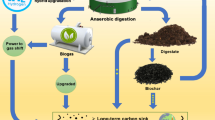Summary
A study of energy usage and distribution in a copper refinery was conducted in an attempt to determine possible cost savings in operations of the plant. The study covered those processes which were the major users of energy, namely, smelting, anode casting, electrolytic refining, steam generation and distribution, and electricity distribution.
The study involved obtaining data of mass and energy flows in the refinery; identifying energy conservation opportunities (ECO’s); obtaining price, operating costs, and saving potentials for each conservation measure; and analyzing the economical viability of each conservation proposal. Potential cost savings were found to be substantial in heat recovery from slag and anode furnace hot gases, modification of the central steam supply system, control, and redistribution of electrical loads, insulation of electrolytic tanks, and changes in the atomization of oil.
Similar content being viewed by others
Author information
Authors and Affiliations
Additional information
Mr. Somers received his BS and MS in mechanical engineering from Lehigh University, Bethlehem, Pennsylvania. Most of his professional career has been spent with the Public Service Electric and Gas Company, Newark, New Jersey, where he specialized in all phases of the engineering of large utility-size power plants. He presently serves in various technical capacities at Energy Engineering Corporation and served as project manager of the project discussed in this article.
Dr. Kurylko received his undergraduate degree from Syracuse University, masters degrees from both Syracuse and Princeton Universities, and PhD from the Pennsylvania State University. He served for ten years as associate professor of mechanical engineering at Stevens Institute of Technology. As staff member of Energy Engineering Corporation, he served as principal field investigator for the project discussed in this article.
Mr. Stone received his undergraduate degree from Hiram College, Ohio and his MS in physical chemistry from Williams College, Massachusetts. He has been involved in the chemical and metallurgical fields with The New Jersey Zinc Company and Asarco. As staff member of Energy Engineering Corporation, he served as field investigator for the project discussed in this paper. He is a member of The Metallurgical Society of AIME.
Mr. Hughen received his BS in metallurgical engineering from the Missouri School of Mines. Before joining USMR, he worked for Blackwell Zinc Company, Inc., Blackwell, Oklahoma. He joined USMR in 1969 and served several years in the Tough Pitch Department and later as an assistant to the vice president of technical services. He also served as manager of the Plant Energy Conservation Program which is described in this article.
Rights and permissions
About this article
Cite this article
Somers, W.E., Kurylko, L., Stone, J.R. et al. A Case Study of Energy Conservation Opportunities in Copper Refining. JOM 34, 41–49 (1982). https://doi.org/10.1007/BF03338050
Published:
Issue Date:
DOI: https://doi.org/10.1007/BF03338050




